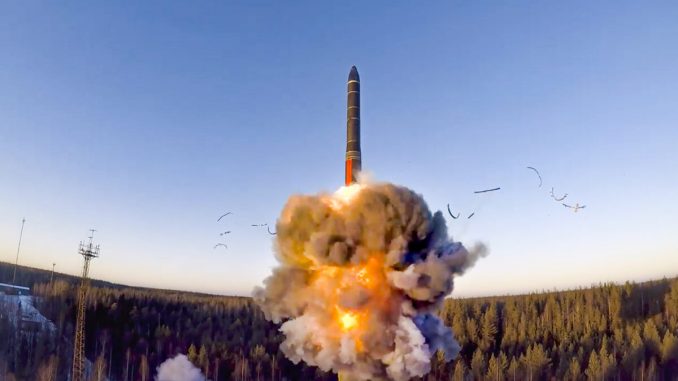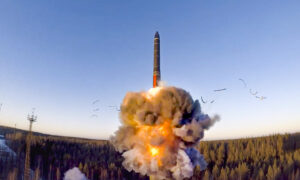

Commentary
If the United States retreats in its nuclear posture during Chinese and Russian nuclear modernization, nuclear war is more likely—not less.
Congressional Democrats have advocated for just that, arguing that the Pentagon budget should be cut, and nuclear weapons production should be shelved. A 2019 Congressional Budget Office (CBO) report pegged (pdf) the cost for overall nuclear modernization over a 10-year period at $400 billion.
“Congress must continue to identify and eliminate additional military bloat, such as the production of needless and dangerous nuclear weapons, which we should be working to rapidly reduce—not expand,” Congressional Progressive Caucus Chairwoman Pramila Jayapal (D-Wash.) said on April 13. “If our national security was preserved during eight years of the Obama-Biden administration, there should be no reason not to return to those levels of military spending under the new Biden-Harris administration.”
Ninety-two of the 218 Democrats in Congress currently belong to this caucus.
Jayapal’s idealism is divorced from reality and a fast-changing nuclear dynamic, according to a recent Pentagon assessment. The threat of overwhelming force is the only way to secure peace. Appeasement never works.
“The spectrum of conflict today is neither linear nor predictable. We must account for the possibility of conflict leading to conditions which could very rapidly drive an adversary to consider nuclear use as their least bad option,” U.S. Strategic Command (STRATCOM) wrote in an April 19 tweet.
Adm. Charles Richard, who oversees STRATCOM, told (pdf) Congress on April 20 that this modernization on the part of China and Russia means we can’t let our guard down and presume that the threat of a nuclear exchange remains low.
“We must maximize our ability to prevent strategic deterrence failure and find ways to reduce the risk of miscalculation in a crisis, by engaging all elements of national power to effectively communicate our resolve to potential adversaries,” Richard said.
China’s buildup of its nuclear capabilities includes sea-based ballistic missile submarines (SSBNs), one of which belonging to the JIN class was commissioned into the Chinese navy in April; development and deployment of its H-20 stealth bomber; and the deployment of intercontinental ballistic missiles (ICBMs) and intermediate range ballistic missiles (IRBMs).
Its development of ICBMs with multiple independently targeted re-entry vehicles (MIRV) that can deliver nuclear warheads against multiple targets makes China particularly dangerous. The country is the largest nation to be completely outside the constraints of any arms control agreement.
The shallow South China Sea has become a bastion for Chinese SSBN activity. China now currently has five SSBNs in its arsenal with the commissioning of the latest submarine. The Defense Department noted (pdf) in 2016 that the JIN class represents a credible nuclear threat to the United States and its allies. JIN-class boats carry up to 12 submarine-launched ballistic missiles (SLBMs).
The Chinese Communist Party-linked Global Times called for China to reach a threshold of 1,000 nuclear warheads last year. That likely will happen in the next decade, Richard wrote in a February article that appeared in Proceedings of the U.S. Naval Institute.
“China’s nuclear weapons stockpile is expected to double (if not triple or quadruple) over the next decade,” Richard wrote, calling its “No-First Use” policy with regard to its nuclear stockpile into question. “Acting in a responsible manner is incumbent upon any great power. For China, we must pay attention to PRC’s actions more than its stated policies.”
China doesn’t disclose exactly how many warheads it has in its arsenal, but it’s believed to have between 200 and 300 warheads.
Russia includes the use of nuclear weapons as part of its land warfare doctrine. It also has upgraded (pdf) its nuclear capabilities with the new Satan 2 ICBM, hypersonic missiles and a rail-mobile ICBM. It also has modernized some of its Cold War-vintage Blackjack intercontinental bombers to deploy nuclear cruise missiles. The Russian navy has deployed several of Russia’s newest SSBN, the Borei class.
Progressive Caucus members in Congress want the land-based component of America’s nuclear deterrence eliminated. The Biden administration remains committed to nuclear modernization in principle, according to the April preliminary funding request to Senate Appropriations Committee Chairman Sen. Patrick Leahy (D-Vt.) (pdf).
“The discretionary request maintains a strong, credible nuclear deterrent for the security of the Nation and U.S. allies. While the Administration is reviewing the U.S. nuclear posture, the discretionary request supports ongoing nuclear modernization programs while ensuring that these efforts are sustainable,” the administration said.
Air Force Gen. John Hyten placed the cost of building the next-generation ICBM, called the ground-based strategic deterrent (GBSD), at $61 billion over the next 10 years ̶ $18 billion more than the 2017 cost projection.
“I think we need a big debate, now that we are in the majority, about the $100 billion acquisition cost of a new intercontinental ballistic missile, the ground-based strategic deterrent,” Sen. Ed Markey (D-Mass.) told Politico in February.
The state of America’s nuclear arsenal is particularly grave. Its youngest weapons were built in the Reagan years and might not work properly. Our Minuteman III ICBMs are ancient and are approaching the point they can no longer be maintained. Silos that house these missiles still use analog technology, and repairs often require airmen to cannibalize from other pieces of equipment.
Cutting the GBSD from the equation sends the message to China and Russia that they would not face an overwhelming nuclear response if they were to use nuclear weapons against the United States or its allies.
The Ohio-class SSBNs that form the backbone of U.S. nuclear deterrence are aging fast, and the replacement Columbia-class SSBNs will not enter service for another decade. It would cost an estimated $86 billion to build 10, according to the CBO (pdf).
The B-21 stealth bomber is expected to enter service in the next decade, replacing B-2s and B-1Bs in the U.S. arsenal. It has an estimated $80 billion price tag for 100 bombers.
“If you don’t have intercontinental ballistic missiles … you are completely dependent on the submarine leg,” Richard told Congress. “I’ve already told the Secretary of Defense that under those conditions, I would request to re-alert the bombers.”
The cost of deterrence is high, but the failure to deter China and Russia would be infinitely higher in terms of lives and economic costs.
John Rossomando is a senior analyst for defense policy at the Center for Security Policy and served as senior analyst for counterterrorism at The Investigative Project on Terrorism for eight years.
Views expressed in this article are the opinions of the author and do not necessarily reflect the views of The Epoch Times.






Be the first to comment